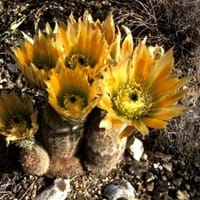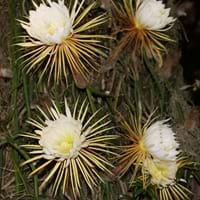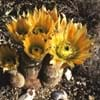Life Span
Perennial
Perennial
Type
Cactus, Flowering Plants, Fruits, Houseplant, native plant natural landscaping, Ornamental Plants, Shrub
Cactus, Flowering Plants
Origin
Not Available
South America, Argentina, Brazil
Types
Not Available
Not available
Habitat
In desert grasslands, Rocky Mountains, sandy seeps, Semi arid regions
Dry Forest, limestone outcrops, Subtropical climates
USDA Hardiness Zone
Not Available
10-14
AHS Heat Zone
Not Available
12-10
Sunset Zone
Not Available
H2, 13, 16, 17, 21, 22, 23, 24
Habit
Upright/Erect
Upright/Erect
Flower Color
Lemon yellow, Light Green, Pink, Red
White, Light Green
Flower Color Modifier
Not Available
Bicolor
Fruit Color
Purple, Purplish Green
Orange, Pink, White, Yellow
Leaf Color in Spring
Not Available
Not Available
Leaf Color in Summer
Not Available
Not Available
Leaf Color in Fall
Not Available
Not Available
Leaf Color in Winter
Not Available
Not Available
Leaf Shape
Succulent
Not Available
Plant Season
Not Available
Spring, Summer, Fall, Winter
Sunlight
Full Sun
Full Sun
Growth Rate
Not Available
Fast
Type of Soil
Not Available
Loam, Sand
The pH of Soil
Not Available
Acidic, Neutral, Alkaline
Soil Drainage
Not Available
Well drained
Bloom Time
Not Available
Late Spring, Early Summer
Repeat Bloomer
Not Available
No
Tolerances
Not Available
Drought, Salt
Where to Plant?
Container, Ground, Pot
Container, Ground
How to Plant?
Seedlings
Cuttings
Plant Maintenance
Medium
Medium
Watering Requirements
Needs very little water
Average Water Needs, Distilled Water, Needs good drainage
In Summer
Lots of watering
Lots of watering
In Spring
Moderate
Moderate
In Winter
Average Water
Average Water
Soil pH
Not Available
Acidic, Neutral, Alkaline
Soil Type
Not Available
Loam, Sand
Soil Drainage Capacity
Not Available
Well drained
Sun Exposure
Full Sun
Full Sun
Pruning
Remove damaged leaves, Remove dead branches, Remove dead leaves
Remove damaged leaves, Remove dead branches, Remove dead leaves
Fertilizers
All-Purpose Liquid Fertilizer
All-Purpose Liquid Fertilizer
Pests and Diseases
Red blotch
Bacterial Stem Rot, Mealy bugs, Red spider mite, Scale
Plant Tolerance
Drought
Drought
Flowers
Not Available
Showy
Flower Petal Number
Not Available
Semi-Double
Showy Fruit
Not Available
Yes
Fragrant Flower
Not Available
Yes
Fragrant Fruit
Not Available
Yes
Fragrant Leaf
Not Available
No
Fragrant Bark/Stem
Not Available
No
Showy Foliage
Not Available
No
Showy Bark
Not Available
No
Foliage Texture
Bold
Bold
Foliage Sheen
Not Available
Not Available
Invasive
Not Available
No
Self-Sowing
Not Available
No
Attracts
Not Available
Birds, Spider Mites
Allergy
Not Available
Avoid during Pregnancy, hallucinations
Aesthetic Uses
Beautification
Showy Purposes
Beauty Benefits
Not Available
Not Available
Edible Uses
Insignificant
Yes
Environmental Uses
Air purification
Air purification
Medicinal Uses
No Medicinal Use
Antidiabetic, Rheumatism, Soothing and relieving pain
Part of Plant Used
Not Applicable
Flowers, Leaves
Other Uses
Decoration Purposes
Traditional medicine, Used for its medicinal properties, Used in herbal medicines
Used As Indoor Plant
Yes
Yes
Used As Outdoor Plant
Yes
Yes
Garden Design
Not Available
Container, Edible, Hedges, Houseplant, Rock Garden, Wall, Tropical
Botanical Name
Echinocereus dasyacanthus
Selenicereus grandiflorus
Common Name
Texas rainbow cactus, Spiny hedgehog cactus
Queen of the night, large-flowered cactus, sweet-scented cactus, vanilla cactus
In Hindi
Echinocereus dasyacanthus
रात की रानी
In German
Echinocereus dasyacanthus
Königin der Nacht
In French
Echinocereus dasyacanthus
Reine de la nuit
In Spanish
Dasyacanthus echinocereus
Reina de la noche
In Greek
Echinocereus dasyacanthus
Βασίλισσα της νύχτας
In Portuguese
Echinocereus dasyacanthus
Rainha da noite
In Polish
Echinocereus dasyacanthus
Królowa nocy
In Latin
Echinocereus dasyacanthus
Domina noctis
Phylum
Magnoliophyta
Magnoliophyta
Class
Magnoliopsida
Magnoliopsida
Order
Caryophyllales
Caryophyllales
Family
Cactaceae
Cactaceae
Genus
Echinocereus
Selenicereus
Clade
Angiosperms, Core eudicots, Eudicots
Angiosperms, Core eudicots, Eudicots
Tribe
Pachycereeae
Hylocereeae
Subfamily
Cactoideae
Cactoideae
Number of Species
Not Available
Importance of Rainbow Cactus and Queen of the Night
Want to have the most appropriate plant for your garden? You might want to know the importance of Rainbow Cactus and Queen of the Night. Basically, these two plants vary in many aspects. Compare Rainbow Cactus and Queen of the Night as they differ in many characteristics such as their life, care, benefits, facts, etc. Every gardener must at least have the slightest clue about the plants he wants to plant in his garden. Compare their benefits, which differ in many ways like facts and uses. The medicinal use of Rainbow Cactus is No Medicinal Use whereas of Queen of the Night is Antidiabetic, Rheumatism and Soothing and relieving pain. Rainbow Cactus has beauty benefits as follows: Not Available while Queen of the Night has beauty benefits as follows: Not Available.
Compare Facts of Rainbow Cactus vs Queen of the Night
How to choose the best garden plant for your garden depending upon its facts? Here garden plant comparison will help you to solve this query. Compare the facts of Rainbow Cactus vs Queen of the Night and know which one to choose. As garden plants have benefits and other uses, allergy is also a major drawback of plants for some people. Allergic reactions of Rainbow Cactus are Not Available whereas of Queen of the Night have Avoid during Pregnancy and hallucinations respectively. Having a fruit bearing plant in your garden can be a plus point of your garden. Rainbow Cactus has no showy fruits and Queen of the Night has showy fruits. Also Rainbow Cactus is not flowering and Queen of the Night is not flowering . You can compare Rainbow Cactus and Queen of the Night facts and facts of other plants too.





